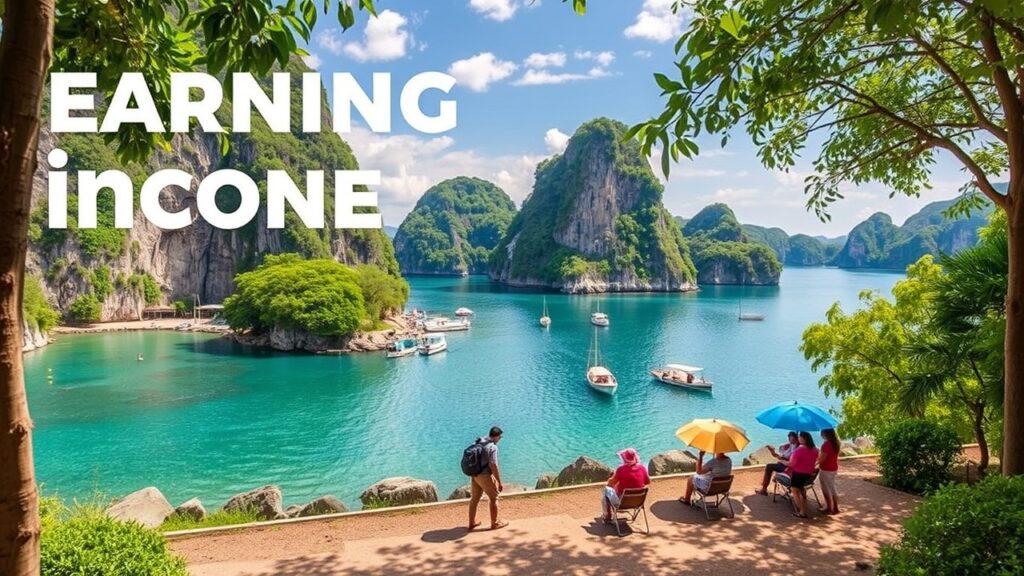10 Secrets You Don’t Know About Earning Income from International Tourism

Have you ever wondered how tourism, one of the world’s most dynamic industries, can be a source of significant income—especially on a global scale? If you’ve only considered the basics of earning money from travel, you might be missing out on untapped opportunities. International tourism is far more than just booking a flight and hotel; it’s a complex ecosystem with numerous ways to generate income, many of which remain hidden to most entrepreneurs.
In this blog, we’ll uncover 10 secrets that could completely change the way you think about earning from international tourism. From discovering niche markets to leveraging digital tools, we’ll explore innovative strategies that can lead you to profit. Whether you’re a seasoned tourism operator or a newcomer looking to break into the industry, these insights will empower you to maximize your revenue streams and position your business for long-term success. Ready to unlock the secrets of international tourism and boost your income? Let’s dive in!
I. The Growing Power of International Tourism in the Global Economy
When we think about the global economy, one sector that often flies under the radar is international tourism. But what if I told you that tourism isn’t just a luxury for vacationers—it’s a powerful engine that drives economies, creates jobs, and unlocks incredible revenue streams? If you’re in the business of travel or considering entering it, this is a sector you can’t afford to overlook.

Understanding the Global Impact of Tourism
International tourism is not just a matter of people hopping from one country to another. In fact, it has become one of the largest economic sectors worldwide. According to the United Nations World Tourism Organization (UNWTO), tourism accounts for roughly 10% of global GDP. But why does this matter to you? The answer is simple: tourism’s expansive reach means that almost every region, large or small, has the potential to tap into this revenue stream.
Whether you’re offering tours, accommodations, or unique local experiences, you’re part of a larger system driving global economic growth. This interconnectedness means more opportunities for business owners like you to generate income from international visitors.
Economic Contributions from Tourism Spending
It’s easy to assume that international tourists only spend on flights and hotels, but the reality is far broader. When a tourist visits a destination, their spending touches a wide range of sectors. Think about it—there’s the transportation they use once they arrive, the restaurants they dine at, the local shops they explore, and the attractions they visit. All these contribute to the economy in ways you might not immediately realize.
Some of the most significant revenue comes from:
- Local businesses: Restaurants, souvenir shops, and transportation services all see increased revenue when international visitors arrive.
- Hospitality services: Hotels, resorts, and even short-term rental platforms like Airbnb benefit from the influx of tourists seeking accommodations.
- Tourist attractions and activities: Museums, amusement parks, and outdoor adventures thrive on ticket sales, guided tours, and experiential activities that draw in global travelers.
So, how can you maximize your piece of this pie? By understanding where international tourists are spending their money, you can tailor your offerings to meet their needs.
Tourism’s Role in Job Creation and Regional Growth
Beyond direct spending, tourism has a profound impact on job creation, particularly in areas where tourism is a primary economic driver. From tour guides and hotel staff to local artisans and event planners, the tourism industry creates a ripple effect that supports countless jobs.
For local communities, international tourism can be a lifeline, helping to:
- Create sustainable employment: As the tourism industry grows, so do the job opportunities in hospitality, entertainment, and transportation.
- Boost regional infrastructure: Cities and towns often invest in better roads, airports, and communication systems to attract more international tourists. This not only makes it easier for tourists to visit but also benefits the local population.
- Foster cultural exchange: Tourists bring with them a diversity of cultures, helping to enrich the social and economic fabric of their destination.
By recognizing the broader economic influence of international tourism, you can position yourself and your business to tap into a growing market. Whether you’re an entrepreneur just getting started or an established business looking to scale, understanding the powerful impact of tourism will help you make informed, profitable decisions.
In the next section, we’ll explore how identifying and targeting niche tourism markets can significantly boost your income potential. Stay tuned!
II. Unlocking Untapped Revenue Streams in Niche Markets
Have you ever thought about catering to niche tourism markets? While mass tourism often gets the spotlight, niche tourism can offer far more profitable and sustainable opportunities. By zeroing in on specific interests and preferences, you can carve out a unique space in the tourism industry and attract travelers who are willing to spend on experiences that speak directly to their desires.
Targeting Specialized Travel Segments (e.g., Eco-Tourism, Adventure Tourism)
Tourism is no longer a one-size-fits-all experience. More travelers today are seeking specialized, meaningful journeys that align with their values and interests. Whether it’s eco-tourism, adventure tourism, or wellness travel, there’s a growing demand for unique, tailored experiences.
Eco-tourism is one such niche that’s gaining momentum. As more people become environmentally conscious, they seek destinations and activities that allow them to connect with nature while minimizing their impact. Here are a few ways to tap into this market:
- Eco-friendly accommodations: Consider offering or partnering with sustainable lodgings, like eco-resorts or glamping sites, where travelers can immerse themselves in nature while supporting sustainable practices.
- Nature-based experiences: Organize guided nature hikes, wildlife watching tours, or volunteering opportunities for conservation projects to appeal to eco-tourists.
Adventure tourism, on the other hand, attracts thrill-seekers looking to push their limits. Whether it’s trekking through remote mountains, diving into the ocean’s depths, or going on safaris, there’s a world of opportunity to cater to adrenaline junkies. You could offer:
- Customized adventure packages that focus on activities like rock climbing, mountain biking, or extreme sports.
- Unique local adventures that can’t be found anywhere else, such as exploring caves, rafting through rivers, or discovering hidden gems of the landscape.
Both of these specialized segments are not just trendy—they’re lucrative. With the right approach, you can build a loyal customer base that returns year after year.
Leveraging Cultural and Heritage Tourism for Unique Offerings
Another niche worth exploring is cultural and heritage tourism. Many travelers seek to immerse themselves in the traditions, history, and artistry of the places they visit. By offering culturally rich experiences, you can attract tourists who want more than just the usual sightseeing.
Some ideas to tap into cultural tourism include:
- Cultural tours and workshops: Offer experiences such as cooking classes, traditional dance lessons, or art and craft workshops where tourists can learn from local artisans.
- Heritage site visits: Collaborate with museums, historical landmarks, and UNESCO World Heritage sites to create guided tours that delve deep into the region’s cultural significance.
This kind of tourism has a staying power because it’s rooted in the preservation of culture and heritage, and as a business owner, you can benefit by providing an enriching, once-in-a-lifetime experience.
The Rise of Medical and Wellness Tourism as a Profit Center
One of the fastest-growing sectors in international tourism is medical and wellness tourism. Travelers are increasingly combining their vacations with health and wellness treatments, seeking everything from medical procedures to spa retreats and wellness resorts. If you’re looking for a niche with significant earning potential, this could be your opportunity.
Here’s how you can cash in on the medical and wellness tourism boom:
- Medical tourism packages: Partner with local hospitals and clinics to offer medical treatments—whether it’s dental work, surgeries, or fertility treatments—alongside a relaxing vacation.
- Wellness retreats: Create or partner with wellness centers that focus on fitness, detox, meditation, or yoga, appealing to health-conscious travelers looking to rejuvenate both body and mind.
The best part about medical and wellness tourism is that it’s not just about the immediate revenue from the services. Tourists are willing to spend significantly on added-value offerings like spa treatments, healthy gourmet meals, and wellness activities. By focusing on this niche, you’re meeting a growing demand and catering to travelers who view their trips as a chance to improve their health, both physically and mentally.
In the next section, we’ll delve into how you can leverage digital innovation and online platforms to increase your reach and profits from the international tourism market. Get ready to take your business to the next level in the digital age!
III. Maximizing Profits Through Digital Innovation and Online Platforms
In today’s digital world, it’s not enough to simply have a physical presence. To truly capitalize on the booming international tourism market, you need to harness the power of digital innovation. With more and more travelers researching, booking, and sharing their experiences online, the tourism industry is increasingly reliant on digital platforms to drive business.
Building a Strong Online Presence to Attract Global Travelers
Your first step in maximizing profits in international tourism is ensuring that potential customers can easily find you online. A strong online presence isn’t just a luxury—it’s a necessity. But what does that really mean for you? Let’s break it down:
- User-friendly website: Your website should be easy to navigate, mobile-responsive, and visually appealing. Potential customers often form their first impression of your business based on your website, so make sure it’s clear, informative, and fast-loading.
- Search Engine Optimization (SEO): To ensure that your website shows up in search results when potential tourists are looking for experiences like yours, you need to focus on SEO. By optimizing your site with the right keywords, you can drive more organic traffic and attract visitors from across the globe.
- Multilingual options: If you want to cater to international travelers, offering your website in multiple languages can be a game-changer. It makes your business more accessible and helps build trust with customers from different countries.
Building a strong online presence isn’t just about attracting people to your site—it’s about converting that traffic into bookings and customer loyalty.
The Power of Booking Engines and Affiliate Marketing for Tourism Businesses
When it comes to booking travel experiences, more tourists than ever are turning to online booking engines. Whether they’re looking for flights, accommodations, tours, or experiences, people are more likely to book their entire trip online. As a business owner, integrating with popular platforms like Expedia, Booking.com, and TripAdvisor can significantly increase your visibility.
However, booking engines aren’t the only way to earn. You can also tap into affiliate marketing to grow your income. Affiliate marketing allows you to earn a commission by partnering with other travel-related businesses. For instance, if you run a tour company, you could promote related services like airport transfers, local accommodations, or travel insurance through affiliate links on your website.
By doing so, you can earn extra income without having to directly manage these additional services, all while providing a more comprehensive solution to your customers. Affiliate marketing also allows you to take advantage of large platforms and networks to reach a broader audience, increasing your chances of making a sale.
The Role of Social Media in Driving International Travel Decisions
Did you know that social media has become one of the most powerful tools for influencing travel decisions? Platforms like Instagram, Facebook, Pinterest, and TikTok are packed with travelers showcasing their journeys, and their posts inspire millions of others to follow in their footsteps. If you want to attract international tourists, you need to be active on social media.
Here’s how you can use social media to drive profits:
- Visually compelling content: Travel is a visual experience, and platforms like Instagram and Pinterest are perfect for showcasing beautiful destinations, unique experiences, and customer testimonials. Post stunning images and videos of the attractions, hotels, or activities that your business offers.
- User-generated content: Encourage your customers to share their own photos and experiences by creating a branded hashtag or running contests. This not only boosts engagement but also acts as social proof, which can influence other travelers to book.
- Influencer partnerships: Collaborate with travel influencers who align with your brand and target market. Influencers can create authentic content that resonates with their followers, helping you reach a much wider audience than you could on your own.
With social media, you have the power to shape potential travelers’ perceptions, build brand awareness, and create a community around your business. By leveraging platforms effectively, you can tap into new markets and drive international bookings.
In the next section, we’ll discuss the importance of strategic partnerships and how collaborating with local and international entities can further boost your revenue. Let’s explore how you can build lasting relationships that help your business grow globally!
IV. Developing Strategic Partnerships with Local and International Entities
As a business owner in the international tourism industry, you don’t have to go it alone. In fact, one of the smartest ways to maximize your earnings is by building strategic partnerships with both local and international entities. These partnerships can help you expand your reach, enhance your offerings, and tap into new revenue streams that you might not have been able to access otherwise. But how exactly can you do this? Let’s dive in.
Collaborating with Hotels, Airlines, and Local Businesses for Cross-Promotions
One of the most effective ways to attract international tourists is by partnering with hotels, airlines, and other local businesses that already cater to travelers. When you form strong cross-promotions with these partners, you create a seamless experience for tourists, making it easier for them to book their entire trip with minimal hassle.
Here are a few collaboration ideas:
- Hotel partnerships: If you offer tours, experiences, or activities, consider teaming up with hotels in the area. Hotels often have visitors who are looking for things to do, so offering them a referral bonus for sending guests your way could be a win-win.
- Airline deals: For businesses that offer unique experiences (like adventure tours or cultural excursions), collaborating with airlines can be lucrative. Airlines may be interested in partnering with you to offer travel packages that include both flights and your services. You could also promote each other’s offerings through discounts and bundled deals.
- Local businesses: Teaming up with local restaurants, shops, and transportation services can help increase your visibility. For example, you could organize a “local experience day” that includes a guided tour, lunch at a local restaurant, and shopping at a nearby craft market.
These collaborations not only help boost your business through referrals and joint promotions, but they also enhance the overall experience for international tourists, making it more likely they’ll book again or refer you to others.
Engaging in Government Tourism Initiatives and Funding Programs
In many regions, local and national governments are eager to promote tourism as a way to stimulate the economy. As a result, there are often government-backed tourism initiatives and funding programs that businesses in the industry can tap into. These programs may provide grants, marketing support, or even tax incentives designed to encourage international tourism.
Consider the following ways to take advantage of government initiatives:
- Tourism development programs: Many governments fund projects that aim to attract more tourists or improve existing tourism infrastructure. By partnering with these programs, you may be able to secure funding for your business or get marketing assistance to reach international visitors.
- Promotional campaigns: Governments often run global tourism campaigns to attract visitors. By being a part of these campaigns, your business could be featured in travel guides, online promotions, or travel fairs, which can significantly boost your international visibility.
Being proactive in seeking out government partnerships can lead to new growth opportunities and help you position your business as a key player in the region’s tourism landscape.
How Influencer Marketing Can Expand Your Reach Globally
In today’s digital age, influencer marketing has become one of the most powerful tools for businesses looking to reach new audiences. Travel influencers, in particular, have the ability to inspire millions of potential customers with just one post. If you want to attract international tourists, collaborating with influencers who specialize in travel could be a game-changer.
Here’s how influencer marketing can benefit your business:
- Global reach: Travel influencers often have followers from around the world. By partnering with influencers who align with your brand and target audience, you can expand your reach and promote your services to international travelers who may never have heard of you otherwise.
- Authentic content: Influencers can create engaging, authentic content that resonates with their followers. Whether it’s a blog post, an Instagram story, or a YouTube video, influencers can showcase your business in a way that feels genuine and relatable, encouraging their audience to book your services.
- Increased trust and credibility: When a trusted influencer recommends your services, it lends credibility to your business. People are more likely to trust the opinions of influencers they follow, making them more likely to book your experience or refer you to others.
Strategic partnerships with influencers can open doors to new markets, boost brand awareness, and increase your bookings. The key is finding the right influencers whose audiences align with your brand’s values and travel offerings.
In the next section, we’ll explore how diversifying your offerings can create multiple income streams and set your business up for sustained success in the international tourism market. Let’s look at how you can offer a variety of experiences that attract travelers year-round!
V. Diversifying Your Offerings to Capture Multiple Income Streams
In an ever-evolving industry like international tourism, the key to long-term success is diversification. Relying on just one type of service or experience may limit your income potential. By diversifying your offerings, you can tap into different markets and keep your revenue flowing year-round, even during off-peak seasons. The more options you provide, the more likely international tourists will find something they’re excited to book.
Offering Travel Packages and Tours for Group and Solo Travelers
Whether it’s a group of friends looking for adventure or a solo traveler seeking a cultural experience, offering a variety of travel packages and tours can help you cater to different types of tourists. Tailoring your offerings to specific groups increases your appeal to a wider range of potential customers.
Consider these two approaches:
- Group packages: Many international tourists prefer traveling in groups to share the experience with others. Offering group tours can attract families, corporate groups, and even school or educational travel. Group packages can include transportation, meals, guided tours, and activities, creating an all-inclusive experience that’s convenient for travelers.
- Solo traveler experiences: Solo travel has been on the rise, with many people seeking personal adventures and unique experiences. Offering specialized tours that cater to solo travelers, such as small-group tours or customizable itineraries, allows you to tap into this growing segment.
By providing both group and solo travel options, you can expand your reach and appeal to a diverse audience, ensuring that there’s always something for everyone.
Monetizing Local Experiences and Events for International Audiences
Another excellent way to diversify your income stream is by monetizing local experiences and events. Tourists love immersing themselves in authentic, local experiences that they can’t find elsewhere, and offering these can be a lucrative source of revenue.
Here are a few ideas to get you started:
- Local cooking classes: International visitors often want to learn about local cuisine. Offering cooking classes or food tours where they can try their hand at traditional dishes is a great way to create a memorable experience.
- Cultural festivals and events: Partner with local festivals, music events, or cultural exhibitions to offer exclusive experiences for tourists. You can create packages that include VIP access, behind-the-scenes tours, or tickets to these events, which will appeal to visitors looking for something special.
- Workshops and hands-on experiences: Whether it’s pottery-making, painting, or crafting, offering workshops that showcase local craftsmanship can attract tourists who want to engage with the culture on a deeper level.
Monetizing these experiences doesn’t just create additional income streams—it enhances the overall tourist experience, encouraging repeat visits and word-of-mouth referrals.
Adding Retail and Merchandise Opportunities to Your Business
Don’t forget the potential income from retail and merchandise. Tourists often love bringing home unique souvenirs as mementos of their travels. By offering branded merchandise or locally made products, you can tap into this lucrative market.
Here are a few ways to incorporate retail into your tourism business:
- Souvenir shops: Whether it’s at your hotel, tour office, or online, selling local handicrafts, souvenirs, or branded merchandise like t-shirts, hats, or tote bags can help you capture additional revenue.
- Online store: If you offer unique experiences or products (like locally crafted jewelry or artwork), consider setting up an online store to sell these items to international customers even after their trip is over.
- Partnerships with local artisans: Partner with local artisans or craftspeople to sell their work at your business. This benefits both your business and the local community, while also giving tourists a chance to take home something truly special.
By diversifying into retail, you can increase your revenue per customer and offer something tangible that reminds them of their experience.
In the next section, we’ll look at how seasonal and event-based tourism can be leveraged to maximize income, and how you can plan your business around peak seasons and special events to capture more international tourists. Let’s explore how timing can become a major asset in growing your tourism business!
VI. Leveraging Seasonal and Event-Based Tourism to Maximize Earnings
The tourism industry is not a year-round business for everyone, and for many destinations, seasonality plays a major role in revenue generation. However, understanding and leveraging both seasonal trends and event-based tourism can provide immense opportunities to maximize your income during peak times while also ensuring business sustainability during the off-seasons.
Planning for Peak Seasons: How to Optimize Your Offerings
Every destination has its own high season—whether it’s summer, winter, or specific holidays. During these peak periods, demand surges, and tourists flock to experience everything your location has to offer. To make the most of these busy times, you need to be proactive in preparing your offerings to meet the influx of travelers.
Here’s how to optimize your business for peak seasons:
- Pre-booking incentives: Encourage early bookings by offering discounts or perks for tourists who plan their trips ahead of time. For example, discounted tours or priority access to popular attractions can be an attractive incentive.
- Expanding your offerings: With higher demand, you may need to expand your services. Consider adding more tour slots, hiring additional staff, or offering special seasonal packages to cater to the increase in visitors.
- Special seasonal promotions: Tailor your marketing efforts to the specific season. For example, if you’re in a ski resort area, promote winter sports packages. Or, if you’re in a coastal region, focus on beach and outdoor adventure tours during the summer months. Make sure to highlight the unique experiences that only happen during those peak times.
Maximizing your offerings during peak seasons will ensure you’re capturing the highest possible revenue. However, planning ahead for off-season periods is equally important.
Attracting Off-Season Travelers: Creating Year-Round Income
While peak seasons can generate high profits, the off-season months shouldn’t be overlooked. International tourists may travel year-round, but to attract them when others aren’t, you need to create offers that appeal to specific types of travelers who seek different experiences outside the traditional peak periods.
- Off-season discounts: Offer discounts or packages to attract travelers during the quieter months. Some tourists prefer to travel during the off-season for fewer crowds and lower prices. A well-timed offer could sway them to book.
- Highlighting unique off-season experiences: Off-season travel can have its own charm. For example, winter in a tropical destination can mean fewer crowds and special events like local festivals or seasonal wildlife. Use this to your advantage by promoting activities that can only be enjoyed during the off-peak period.
- Promote wellness and retreat packages: Many tourists look for quiet, reflective travel experiences during the off-season, such as wellness retreats, yoga getaways, or spa vacations. These experiences can be less in demand during peak periods but highly popular during the off-season.
By diversifying your offerings to cater to off-season travelers, you’ll create a steady stream of revenue throughout the entire year, instead of just relying on a few busy months.
Capitalizing on Major Events and Festivals to Boost Revenue
Special events, festivals, and conferences present a golden opportunity to boost your income and attract international tourists. These events often draw people from all over the world, and businesses that are prepared to cater to these visitors can see significant financial rewards.
Here’s how to capitalize on event-based tourism:
- Event-based packages: If your area is known for hosting annual events like music festivals, sporting events, or cultural celebrations, create special packages that include accommodation, event tickets, and additional services like guided tours or transport.
- Partnering with event organizers: Work directly with event organizers to offer exclusive experiences, such as VIP passes, backstage tours, or group discounts. This can provide an additional layer of appeal to tourists attending the event.
- Targeted marketing campaigns: Use digital marketing strategies to target international tourists who may be planning to attend the event. You can run paid ads or social media campaigns promoting the event alongside your services, ensuring you’re visible to potential customers who might not have considered your business otherwise.
Major events and festivals can attract large crowds and generate spikes in demand, so having the right offerings ready during these times can maximize your revenue potential.
Adapting Your Business Model to Seasonal Fluctuations
Understanding seasonal trends allows you to adapt your business model for greater profitability. It’s not just about reacting to demand—it’s about strategically planning for the ebbs and flows of the tourism industry.
- Flexible pricing strategies: Implement dynamic pricing that adjusts according to demand. This could mean raising prices during peak seasons and offering discounts or value-added services during quieter months to keep a steady stream of business.
- Staffing adjustments: Ensure that you have enough staff during peak seasons, but don’t overhire for the off-season. By managing your staffing needs according to seasonal trends, you can save on labor costs without compromising customer service.
- Product diversification: By offering a mix of experiences that appeal to different traveler types, you can smooth out the seasonal fluctuations in demand. For instance, offering both summer adventure activities and winter wellness retreats will ensure your business remains appealing year-round.
In the next section, we’ll explore how data analytics and customer insights can help you make better, data-driven decisions to continually refine your strategy and increase profits in the international tourism sector. Let’s dive into how you can use smart tools to unlock even more opportunities!
VII. Using Data Analytics and Customer Insights to Drive Smarter Decisions
In the world of international tourism, data analytics and customer insights are invaluable tools that can help you refine your strategies, optimize your offerings, and boost your profits. By leveraging these tools effectively, you can gain a deeper understanding of your customers’ behavior, preferences, and spending patterns, allowing you to make more informed business decisions that drive revenue.
Tracking Visitor Behavior and Preferences with Analytics Tools
Understanding the behavior and preferences of your customers is key to enhancing their experience and increasing bookings. Analytics tools like Google Analytics, social media insights, and booking engine reports allow you to track how visitors interact with your website, what interests them most, and which services they’re most likely to purchase.
Here’s how you can use this data:
- Website traffic: Track which pages of your website are getting the most traffic, and identify which types of tours or services are most popular. By understanding these patterns, you can adjust your marketing strategies to highlight the services that appeal most to your customers.
- Booking data: By analyzing your booking patterns, you can identify trends in peak travel periods, customer preferences, and even geographical locations of visitors. This will help you anticipate demand and better manage your resources during busy seasons.
- Customer demographics: Using customer data, you can learn about the age, location, and interests of your visitors. This allows you to tailor your marketing messages and create targeted campaigns that resonate with specific customer segments.
By integrating data analytics into your tourism business, you can refine your strategies, enhance your offerings, and provide a personalized experience that keeps international tourists coming back.
Using Customer Feedback to Enhance Your Services
Customer feedback is another valuable source of data that can help you improve your business. Gathering reviews and ratings from tourists gives you insight into what’s working well and where you can improve. Tourists love sharing their experiences, and listening to their feedback can reveal important details about their preferences, needs, and pain points.
Here’s how you can leverage customer feedback:
- Online reviews: Monitor reviews on platforms like TripAdvisor, Google, and social media. Pay attention to common compliments and criticisms, and use this information to improve your services or address potential issues.
- Surveys: Send post-experience surveys to tourists to gain detailed insights into their satisfaction levels and gather suggestions for improvement. You could ask questions about the quality of your tours, the booking process, customer service, and overall satisfaction.
- Direct communication: Don’t be afraid to engage directly with customers to ask for feedback. Building a relationship with past tourists and encouraging them to share their thoughts can help foster loyalty and give you valuable insights that will make your business more attractive to future clients.
By acting on customer feedback, you not only improve the overall experience but also show that you value their opinions, which in turn builds trust and loyalty among your international clientele.
Predictive Analytics: Anticipating Trends and Optimizing Resources
In addition to tracking past data, predictive analytics allows you to forecast future trends and optimize your resources. By analyzing historical data and using advanced algorithms, you can anticipate shifts in demand, identify emerging trends, and make smarter decisions about when and where to allocate your resources.
Here’s how you can benefit from predictive analytics:
- Demand forecasting: Predict when your business will experience high or low demand, so you can adjust staffing levels, pricing strategies, and marketing efforts accordingly.
- Personalization: Use data to create personalized offers for repeat customers. If you know a customer is likely to travel again, you can send them tailored promotions or discounts based on their previous experiences.
- Market expansion: Predict which international markets are likely to generate the most revenue in the coming months or years. By identifying emerging trends in global tourism, you can adapt your offerings to attract new customers from growing markets.
Predictive analytics helps you stay ahead of the curve, allowing you to make proactive decisions that maximize profitability.
Enhancing Customer Retention with Loyalty Programs
While attracting new international tourists is important, customer retention is equally crucial for sustained growth. Implementing loyalty programs can incentivize repeat visits and encourage customers to return to your services, even if they’re traveling to the same destination multiple times.
Here are a few ideas for building a strong loyalty program:
- Rewards points: Offer rewards points for every booking made, which customers can redeem for discounts, free upgrades, or exclusive experiences. This encourages tourists to book with you again and again.
- VIP experiences: Provide loyal customers with access to VIP treatment, such as private tours, priority booking, or exclusive events. By making customers feel special, you increase the chances of them becoming long-term brand advocates.
- Referral incentives: Reward customers who refer others to your business with special deals or free services. Word-of-mouth marketing is incredibly powerful, especially when it comes from satisfied customers.
Unlock Your Potential in the International Tourism Market
As we’ve seen throughout this guide, there’s incredible potential to earn income from international tourism, but success doesn’t happen overnight. Whether you’re just starting out or you’re looking to elevate an established tourism business, the strategies outlined in this post can help you build a sustainable and profitable venture.
So, how will you position your business for growth?
The tourism market is dynamic, offering countless opportunities to innovate and cater to a diverse group of travelers. By understanding tourism trends, cultivating strong strategic partnerships, and diversifying your offerings, you can tap into multiple revenue streams, ensuring your business thrives no matter the season.
Don’t forget about the power of data analytics and customer insights. By leveraging these tools, you can make smarter decisions that align with the preferences of international tourists, creating a personalized experience that keeps them coming back for more. And with the right approach to seasonal and event-based tourism, you’ll be able to maximize your earnings during peak periods while maintaining a steady stream of income throughout the year.
Now, take a moment and reflect on your own business. What are the untapped opportunities waiting for you? What could you do differently to attract more international visitors and increase your revenue? The world of tourism is vast, and by continuously adapting and innovating, your business can unlock endless possibilities.
Remember, success in international tourism isn’t about following the same path as everyone else—it’s about creating memorable, unique experiences that resonate with travelers from around the globe. With the right strategies, tools, and mindset, you can unlock the full potential of the international tourism market and establish your brand as a trusted name in the industry.
Are you ready to take the next step in building a thriving tourism business? The opportunities are out there—it’s time to seize them!







